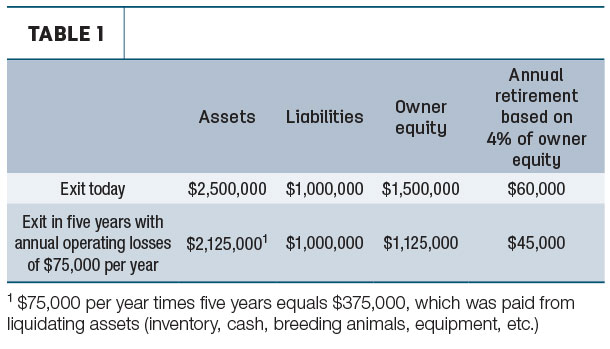However, we may ask the same questions of a farm business: When is it time to gracefully exit, and when are we trying to stay in the business too long, beyond peak performance?
It is a multifaceted question, the answer to which will be unique for each individual, family and operation. It is also not all financial. Economists will tell us people seek to maximize a concept called “utility” versus just profits. Other words for utility are happiness or satisfaction. The theory holds that utility encompasses many aspects, financial and non-financial, which either help the individual gain or lose happiness/satisfaction.
As agricultural producers contemplate exiting, many factors are weighed: leisure, health, lifestyle, family, economy and, of course, financial. The following are four overall areas of consideration in the thinking and planning for a business exit:
1. Infrastructure
Production agriculture is a capital-intensive business. Updating or replacing buildings, machinery and even the breeding herd takes money and a lot of it. Whether it is debt or equity capital, it is an investment that will take multiple years to recover and likely requires a new or at least updated set of management skills. Thoughts on that challenge are much different at 25 years old versus 55. For the older operator, it may be more advantageous to “use up” the existing infrastructure and walk away with equity intact and little to no debt.
2. Timing
Cycles are a part of life, whether it is the cycle of the seasons, the dairy cow or the economy. Typically, the dairy industry is a three-year cycle (a tradition that is being severely challenged right now, as the industry faces its fifth year of low prices). In the beef cattle industry, that cycle is more like eight to 12 years. Like the professional athlete, we would like to exit at the top of our game.
Land, machinery and breeding animals are worth the most at the top of the price cycle, a difference that can be significant in the financial outcome of the exit. As an example, National Agricultural Statistics Service data show that in Wisconsin, the 2015 average dairy cow price was $2,100 while, one year later, in 2016, the price had fallen to $1,850. For 100 cows, the difference of waiting one year equated to a $25,000 difference.
3. Financial
There are many considerations within the financial arena. If the farm business is showing a trend of lower profitability, then it may be time for exit strategies. If working capital is trending lower, it may be due to covering family living, basic replacement, maintenance or debt service from this reserve of capital. Ultimately, it could be an erosion of equity and, in the least, a loss of a risk management tool. Exit may be a more financially sound alternative.
Losing one’s wealth earned over a lifetime of building the business is perhaps the biggest reason for a timely exit. Hanging onto an operation, hoping to push it through until better, more profitable times, may result in a continual drain on equity (the owner’s wealth). In the past, the cycle of the farm business was to grow the business and build equity in early career, pay off debt in mid-career and retire on earned and valuation* equity in late career.
However, too often, the capacity to produce profits succumbs to changes in the industry, technology and management, resulting in the owner living off equity instead of business profits. This is analogous to robbing the retirement fund. Owners would be financially better off exiting before spending their retirement to cover today’s operating losses.
As an example, let’s assume a farm business has the following: assets worth $2.5 million, liabilities equal to $1 million and, thus, $1.5 million of equity. If they were to sell out today and put their $1.5 million of equity into an investment that earned 4 percent, then they would receive $60,000 per year in annual retirement (Table 1).

However, let’s assume they continue to farm for five years. Further, assume herd genetics, older technology and inefficient buildings and equipment are such that the business is losing on average $75,000 per year after family living expenses ($375,000 cumulative for five years). The $75,000-per-year shortfall is paid by liquidating assets (inventory, working capital, equipment, land, etc.). That is, the farm owner is living off equity rather than business profits and spending down their retirement fund.
As any farm owner will tell you, there will always be times when living off equity is the only alternative left in the short term. The question is, do you see the profitability picture changing when the short-term situation is over? If your answer is doubtful, then exit – or at least some partial exit might be a wise management decision.
4. Family
There are many non-financial reasons for either exiting today or waiting, including health, stress, preferences for how to spend time and family considerations. Is there a transition to the next generation involved? Is it a multiple generation family farm – a value not easily measured in dollars? Is it the family “vacation” or “hunting” retreat?
Other considerations
Consideration can also be given to the form of exit. It could be an outright sale of all assets, slow ownership transfer over a number of years, rent-to-own arrangement or some combination. Retirement needs, family wishes and even taxes all play a role in the optimal exit strategy. ![]()
Kevin Bernhardt is a farm management specialist with the Center for Dairy Profitability and UW Extension, and professor of agribusiness at University of Wisconsin-Platteville School of Agriculture.
* Valuation equity is the wealth an owner accrues due to the market value of capital assets over their book value. In agriculture, land is a major source of valuation equity. One hundred acres of unimproved land purchased for $500 per acre and now worth $6,000 per acre is $550,000 of wealth accumulated through land appreciation. Valuation equity is traditionally a major source of retirement capital.
Kevin Bernhardt is a farm management specialist with the Center for Dairy Profitability and UW Extension. Email Kevin Bernhardt.






